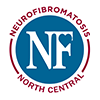What is NF-1?
Neurofibromatosis causes unchecked growth of tissue along the nerves. This can put pressure on affected nerves and cause pain, severe nerve damage, and loss of function in the area served by the nerve. Problems with sensation or movement can occur, depending on the nerves affected. The condition can be very different from person to person, even among people in the same family who have the NF1 gene. The “coffee-with-milk” (café-au-lait) spots are the hallmark symptom of Neurofibromatosis. Although many healthy people have 1 or 2 small café-au-lait spots, adults with 6 or more spots 1.5 cm in diameter or greater are likely to have Neurofibromatosis. In most people with the condition, these spots may be the only symptom.
Diagnostic Criteria for NF-1
Two or more of the following:
- Six or more café-au-lait spots 1.5 cm or larger in post-pubertal individuals;
- Six or more café-au-lait spots 0.5 cm or larger in pre-pubertal individuals;
- Two or more neurofibromas of any type OR one or more plexiform neurofibromas;
- Freckling in the axilla or groin;
- Optic glioma (tumor of the optic pathway);
- Two or more Lisch nodules (benign tumors of the iris called “hamartomas”);
- A distinctive bony lesion: dysplasia of the sphenoid bone or dysplasia or thinning of long bone cortex;
- A first-degree relative with NF1
Effects of NF-1
Neurofibromatosis type 1 (NF-1) is an autosomal dominant genetic disorder that causes tumors to grow on the covering of the nerves anywhere in the body, at any time. The disorder affects 1 in 2,500 and affects all races, ethnic groups, and both genders, equally. The NF-1 gene is located on chromosome 17. Other symptoms may include:
- Blindness
- Seizures
- Freckles in the underarm or groin
- Large, soft tumors called plexiform neurofibromas, which may have a dark color and may spread under the surface of the skin
- Pain (from affected peripheral nerves)
- Small, rubbery tumors of the skin called cutaneous neurofibromas (cNFs)
RESOURCES
- Webinars for those impacted by NF
- Understanding Neurofibromatosis (ebook)
- Understanding Neurofibromatosis Type 2 (ebook)
In Their Own Words

